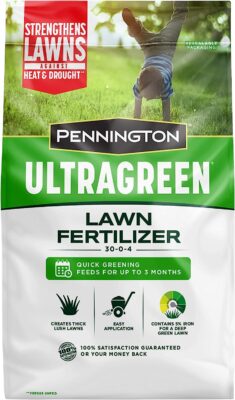Bahia grass is a tough, drought-resistant, ornamental warm-season turf native to Brazil. It thrives in U.S. home lawns; some gardeners grow it in roadside vegetation. The grass has a flattering appearance and grows aggressively even in saline, sandy, and less fertile soils, but that doesn’t mean the grass gets thicker and fuller naturally. If you’re thinking about how to make Bahia grass thicker, read the following steps.
You can make Bahia grass thicker by improving the soil quality and cutting all tall and unwanted plants shading the lawn. Overseeding also helps create a thicker and lusher lawn by filling spaces between the existing turf and new grass.
Furthermore, following the right maintenance schedule, like watering, fertilizing, mowing, and controlling weeds, can help thicken your lawn.
4 Easy Steps to Making Behaya Grass Thicker
Here are the top four grass bahia maintenance secrets no one will ever tell you:
1. Improve your soil quality
You should improve your yard’s soil pH and other conditions to achieve a thick and healthy lawn. Low soil pH inhibits grass from absorbing essential nutrients. Therefore, conduct soil testing to know whether your yard requires lime or other nutrients that help thicken grass Bahia.
2. Remove shade
Behaya grass flourishes under full sunlight. Therefore, clear all tall and unwanted plants growing next to your lawn. This helps the turf to grow thick and fuller as it gets full sunlight.
3. Overseed
Overseeding refers to planting grass seeds into existing turf to prevent the lawn from thinning or thickening. So, make Bahia grass thick by overseeding it during spring.
4. Follow the correct Bahia grass lawn maintenance schedule
Bahia grass lawn requires regular maintenance to remain healthy and thick. For instance, you must water the lawn consistently, fertilize as required, mow the grass correctly, and control weeds regularly.
Bahia Grass Maintenance Schedule

i. Watering
Bahia grass will grow thicker if you keep watering it regularly. Although it is tolerant to drought and requires less water to thrive, you must give new sod adequate water. Additionally, the grass goes dormant during prolonged drought periods and turns brown. In this case, regular watering helps keep it thick and strong.
Therefore, apply 3/4 to 1 inch of water daily to the new grass until it establishes fully. From there, you can give the lawn 1 inch of water weekly.
ii. Fertilizing
Following the proper Bahia grass fertilizer schedule is advisable to achieve a healthier, thicker lawn. For healthy growth, fertilize the grass when planting with a slow-release starter fertilizer.
Once fully established, feed the turf annually with nitrogen, phosphorus, and potassium fertilizer.
iii. Mowing
You should mow Bahiagrass at 3 to 4 inches every one to two weeks during the growing season. This helps encourage deep roots. Avoid removing more than 1/3 of the leaf blade, which will stress and weaken your grass.
iv. Weed Control
Bahia grass is prone to weeds like crowfoot, goosegrass, crabgrass, and sandbur. Therefore, remove them by digging with a sharp spade, hand pulling, or applying glyphosate herbicide.
Frequently Asked Questions (FAQs)
Q: What is the best fertilizer to thicken grass?
A: Any fertilizer containing phosphorus helps thicken grass. Phosphorus is a vital nutrient that helps boost root development and enhances the growth of robust plants. To thicken the Bahia lawn and make it greener, add Pennington UltraGreen Lawn Fertilizer 30-0-4 (pictured below).

Q: Will lime help thicken grass?
A: Adding lime to soil helps maintain the proper pH range for turf to thrive. So, lime helps keep the soil at the optimal pH, making all essential nutrients from lawn fertilizer available. This allows the turf to grow healthier, fuller, and thicker.
Final Word
Bahia grass is ideal for southeastern U.S. lawns as it thrives in sandy soils and hot and dry climates. However, it takes some work to maintain a healthier, thicker lawn as it thins out over time.
If you’re stressed about how to make Bahia grass thicker, follow these steps: Improve the soil quality, remove shade, overseed the lawn, and maintain the lawn regularly by watering, fertilizing, mowing, and controlling weeds.


